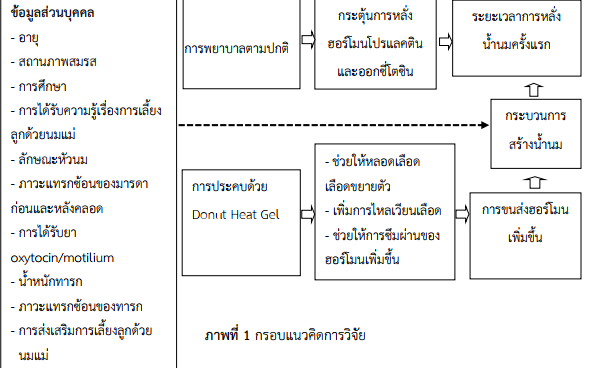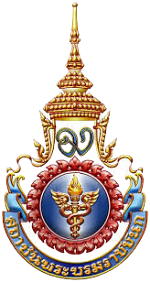ผลของการใช้นวัตกรรม Donut Heat Gel ต่อระยะเวลาการหลั่งน้ำนมครั้งแรกในมารดา หลังคลอด หอผู้ป่วยหลังคลอด โรงพยาบาลพัทลุง
คำสำคัญ:
การหลั่งน้ำนมครั้งแรก, นวัตกรรม Donut Heat Gel, มารดาหลังคลอด, การเลี้ยงลูกด้วยนมแม่บทคัดย่อ
การวิจัยกึ่งทดลองนี้ มีวัตถุประสงค์เพื่อเปรียบเทียบผลการประคบเต้านมด้วยนวัตกรรม Donut Heat Gel ต่อระยะเวลาการหลั่งน้ำนมครั้งแรกในมารดาหลังคลอด กลุ่มตัวอย่างเป็นมารดาหลังคลอดครรภ์แรกที่คลอดปกติทางช่องคลอดและมีภาวะน้ำนมไม่ไหลที่เข้ารับการรักษาในหอผู้ป่วยหลังคลอด โรงพยาบาลพัทลุง ตั้งแต่เดือนเมษายน - พฤศจิกายน พ.ศ. 2563 จำนวน 60 ราย ทำการคัดเลือกกลุ่มตัวอย่างแบบเจาะจง ตามคุณสมบัติที่กำหนด แบ่งเป็นกลุ่มทดลอง และกลุ่มควบคุม กลุ่มละ 30 ราย โดยกลุ่มควบคุมจะได้รับการพยาบาลตามปกติ ส่วนกลุ่มทดลองจะได้รับการประคบเต้านมด้วยนวัตกรรม Donut Heat Gel เครื่องมือที่ใช้ในการศึกษามี 2 ส่วน คือ นวัตกรรม Donut Heat Gel และแบบบันทึกในการรวบรวมข้อมูล ซึ่งแบบบันทึกการส่งเสริมการเลี้ยงลูกด้วยนมแม่ และแบบประเมินระดับการไหลของน้ำนม มีค่าดัชนีความตรงเชิงเนื้อหา เท่ากับ 0.90 และ 0.80 ตามลำดับ และมีค่าความเที่ยงเท่ากับ 0.80 และ 0.90 ตามลำดับ วิเคราะห์ข้อมูล โดยใช้ความถี่ ร้อยละ ค่าเฉลี่ย ส่วนเบี่ยงเบนมาตรฐาน และวิเคราะห์เปรียบเทียบค่าเฉลี่ยระยะเวลาการหลั่งน้ำนมครั้งแรกของกลุ่มที่ได้รับการพยาบาลตามปกติกับได้รับการประคบเต้านมด้วยนวัตกรรม Donut Heat Gel
โดยใช้ Independent t-test
ผลการวิจัย พบว่า ระยะเวลาการหลั่งน้ำนมครั้งแรกในมารดาหลังคลอดที่ได้รับการประคบด้วยนวัตกรรม Donut Heat Gel มีค่าเฉลี่ย 20.54 ชั่วโมง กลุ่มที่ได้รับการพยาบาลตามปกติ มีค่าเฉลี่ย 32.36 ชั่วโมง และกลุ่มที่ได้รับการประคบเต้านมด้วยนวัตกรรม Donut Heat Gel มีระยะเวลาการหลั่งน้ำนมครั้งแรกสั้นกว่ากลุ่มที่ได้รับการพยาบาลตามปกติอย่างมีนัยสำคัญทางสถิติ (t= 7.50, p < .001) ผลการศึกษา แสดงให้เห็นว่า การประคบด้วยนวัตกรรม Donut Heat Gel ทำให้มีการหลั่งน้ำนมเร็วขึ้น และส่งผลต่อความสำเร็จในการเลี้ยงลูกด้วยนมแม่
ข้อเสนอแนะ ควรนำนวัตกรรม Donut Heart Gel มาใช้ในการกระตุ้นการไหลของน้ำนมในมารดาหลังคลอดปกติที่ไม่มีภาวะแทรกซ้อน
เอกสารอ้างอิง
Amir, L. H., & Donath, S. (2007). A systematic review of maternal obesity and breastfeeding intention, initiation and duration [Electronic version]. BMC Pregnancy and Childbirth, 7, 9.
Anukoolprasert, P. (2007). Comparison between breast massage alone and breast massage combined with a warm compress in increasing milk production in post-partum mothers. Journal of Health Systems Research, 1(3-4), 430-438.
Burns, N., & Grove, S. K. (2005). The practice of nursing research: Conduct, critique, andutilization. St. Louis, Mo.: Elsevier Saunders.
Buttham, S., Kongwattanakul, K., Jaturat, N., & Soontrapa, S. (2017). Rate and factors affecting non-exclusive breastfeeding among thai women under the breastfeeding promotion program. International Journal of Women’s Health, 9, 689-694.
Cohen, J. (1988). Statistical power analysis for the behavioral sciences. (2nd ed.). Hillsdale, NJ: Lawrence Erlbaum Associates, Publishers.
Godfrey, J. R.,& Lawrence, R. A. (2010). Toward optimal health: The maternal benefits of breastfeeding. Journal of Women’s Health, 19(9), 1597-1602.
Hurst, N. M. (2007). Recognizing and treating delayed or failed lactogenesis II. Journal of Midwifery & Women’s Health, 52(6), 588-594.
Jeerasap, R., Phaiboonbunpot, N., & Panikom, S. (2010). Routes of delivery and onset of lactation. Journal of Health Science, 19(2), 270-278.
Kent, J. C., Prime, D. K., & Garbin, C. P. (2012). Principles for maintaining or increasing breast milk production [Electronic version]. Journal of Obstetric, Gynecologic & Neonatal Nursing, 41(1), 114-121.
Khotsang, K., Sangin, S., & Chuahorm, U. (2016). The effects of lactational program on milk secretion time, onset of lactation and breastfeeding self-efficacy in mothers after cesarean section. The Journal of Faculty of Nursing Burapha University, 24(1), 12-26.
Lawrence, R. A., & Lawrence, R. M. (2011). Breastfeeding: A guide for the medical profession. (7th ed.). St. Louis: Mosby.
Mannel, R., Martens, P. J., & Walker, M. (2013). Core curriculum for lactation consultant Practice. (3rd ed.). Burlington, MA: Jones & Bartlett Learning.
Meedya, S., Fahy, K., & Kable, A. (2010). Factors that positively influence breastfeeding duration to 6 months: A literature review. Women and Health, 23, 135-145.
Murry, S. S., & McKinney, E. S. (2014). Foundations of maternal-newborn and woman’s health Nursing. (6th ed.). St. Louis, MO: Elsevier.
National Statistical Office. (2013). Multiple indicator cluster surveys Thailand 2011-2012. Bangkok. (in Thai)
Nommsen-Rivers, L. A., Chantry, C. J., Peerson, J. M., Cohen, R. J., & Dewey, K. G. (2010). Delayed onset of lactogenesis among first time mothers is related to maternal obesity and factors associated with ineffective breastfeeding [Electronic version]. The American Journal of Clinical Nutrition, 92(3), 574-584.
Noonan, M., & Rippeyoung, P. (2011). The economic costs of breastfeeding for women. Breastfeeding Medicine, 5(6), 325-327.
Panngam, N., Theerasopon, P., & Ungpansattawong, S. (2016). The effect of warm moist polymer gel pack compression on the onset of milk production in primiparous mothers. Journal of Phrapokklao Nursing College, 27(1), 28-38.
Pakdeechot, S., Morarad, R., & Sakontarat. (2010). The effect of Increasing milk production program on secretion time of colostrum in postpartum mothers, Sakon Nakhon hospital. Journal of Health Science,19(2), 279-287.
Sakontarat, P. & Pakdechote, S. (2012). Comparison between hot herbal comparison and warm comparisonin increasing milk production in pospartum mothers, Sakonnakhon hospital. Journal of SakonNakhon Hospital, 15(3), 1-10.
Somjit, T., Phahuwatanakorn, W., & Yusamran, C. (2019). Intrapartum factors influencing onset of lactogenesis II after delivery. Journal of Nursing and Health Care, 37(4), 119-127.
Trainapakul, C., Chaiyawattana, M., Kanavitoo, W., Tiumtaogerd, R., Naka, S., & Mitrniyodom, W., et al. (2010). Effect of milk ejection performance of postpartum mothers after breasts massage and compression with mini hot bag and herbal compress. Journal of Nursing and Education, 3(3), 75-91.
Wahyuningsih, M., & Liliana, A. (2019). The effectiveness of warm compress on breast milk production among postpartum mother in tegalrejo health center. Healthy and Active Ageing. 736-740.
Walker, M. (2014). Breastfeeding management for the clinician: Using the evidence. (3rd ed.). Burlington, MA: Jones & Bartlett Learning.
Wambach, K. & Riordan, J. (2016). Breastfeeding and human lactation. (5th ed.). Jones & Bartlett Learning. LLC, an Ascend Learning Company.
World Health Organization. (2017). Guideline: protecting, promoting and supporting breastfeeding in facilities providing maternity and newborn services. Geneva: WHO Document Production Service.

ดาวน์โหลด
เผยแพร่แล้ว
รูปแบบการอ้างอิง
ฉบับ
ประเภทบทความ
สัญญาอนุญาต
ลิขสิทธิ์ (c) 2021 วิทยาลัยพยาบาลบรมราชชนนี นครศรีธรรมราช

อนุญาตภายใต้เงื่อนไข Creative Commons Attribution-NonCommercial-NoDerivatives 4.0 International License.
บทความที่ได้รับการตีพิมพ์เป็นลิขสิทธิ์ของ วิทยาลัยพยาบาลบรมราชชนนี นครศรีธรรมราช
ข้อความที่ปรากฏในบทความแต่ละเรื่องในวารสารวิชาการเล่มนี้เป็นความคิดเห็นส่วนตัวของผู้เขียนแต่ละท่านไม่เกี่ยวข้องกับวิทยาลัยพยาบาลบรมราชชนนี นครศรีธรรมราช และบุคคลากรท่านอื่น ๆ ในวิทยาลัยฯ แต่อย่างใด ความรับผิดชอบองค์ประกอบทั้งหมดของบทความแต่ละเรื่องเป็นของผู้เขียนแต่ละท่าน หากมีความผิดพลาดใดๆ ผู้เขียนแต่ละท่านจะรับผิดชอบบทความของตนเองแต่ผู้เดียว





